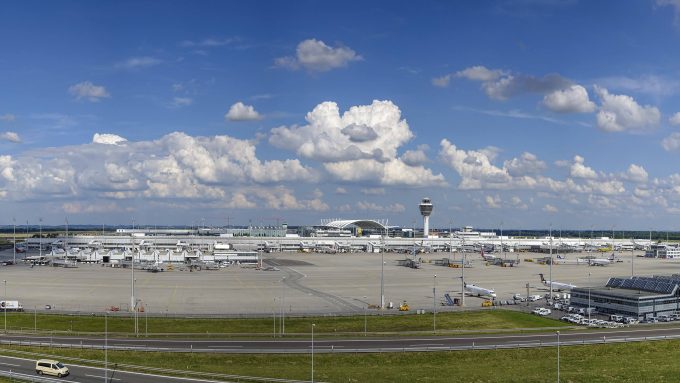Case Study
Senstar Symphony™ video, security and information platform helping to keep passengers and staff safe at “Europe’s best airport”
From the perimeter of the airfields to the inner halls of the terminals, ensuring the airport is safe for passengers, crew and staff is critical. With so many different areas to monitor, video surveillance is a must, but cameras alone do not provide sufficient security. What is required is a system that easily manages footage from hundreds of cameras, alerts security personnel to possible issues, analyzes real-time situations to ensure proper response and/or follow-up, and gathers business intelligence to help improve efficiencies.
For “Europe’s best airport” – Munich International in Munich, Germany – the Senstar Symphony video, security and information management platform has improved security, streamlined operations, and increased customer satisfaction. “With intelligent video software, we are able to analyze passenger flows and avoid upcoming problems,” according to Johann Götz, Head of ITN, Munich International Airport.
Roll Out Deployments With Ease
Munich International Airport uses Symphony to multicast video streams and distribute video to over 250 concurrent operator stations while ensuring high availability and maintaining compliance with airport defined user rights and access privileges.
Symphony’s open system architecture runs on standard commercial off-the-shelf hardware and supports as many different video sources as required. Flexible live viewing options – including video wall, web, thin client, and mobile clients – ensures every user group gets a customized presentation of video information.
Scalable Now And In The Future
“We selected this system because of its scalability, expandability, and configurability,” said Michael Zaddach, CIO Munich International Airport.
Senstar Symphony is highly scalable and able to grow as required. The same software is used regardless of deployment size or server function (one software platform for video storage and playback, analytics, and management). If increased camera counts, additional analytic processes, or video quality improvements necessitate more server-side processing resources, the operator simply runs the Symphony installer software on the new hardware in the server farm. Existing video clients do not require reconfiguration.
In the case of Munich International Airport the initial installation used 2,000 cameras but recently grew to 3,200. The airport was able to add the additional resources while avoiding having to re-configure their existing system or switch to a different software licensing scheme.
Maximize Server Investments: High Camera Density With Redundancy
Running Munich International Airport’s 3,200 cameras is no small feat, but for Symphony, which supports one of the highest camera-density-per-server capabilities on the market, only 14 servers (plus seven redundant servers) are required. A low number of servers not only saves on capital expenditures but also provides a Return-on-Investment (ROI) from reduced operating expenditures via reduced electrical, cooling and maintenance requirements.
When used with an Enterprise license, Symphony includes built-in server redundancy and automatic failover. If a Symphony server stops responding, camera and device processing moves to another Symphony server. If a storage device fails, the system also automatically switches to another one, ensuring critical video data is not lost.
Direct Operator Attention To Key Events
With Symphony’s analytic software components, users can identify problems early and follow them through the timeline.
Munich International Airport uses Symphony’s Outdoor People and Vehicle Tracking (OPVT) analytic on 50 channels to protect perimeter areas and important assets.
Symphony OPVT enables airport officials to detect and monitor the movement of vehicles or people moving through an area, such as parking lots or airplane loading zone. OPVT offers extremely high tracking and classification accuracy while providing information on where an object came from and where it left the camera’s point of view. Establishing rules to trigger alarms helps operators focus on the activity in the scene that matters most.
Improve Operational Efficiencies
Symphony can also help improve operational efficiencies. An example at Munich International Airport is of Symphony assisting ground crew who service more than 400,000 takeoffs and landings each year. Cameras are positioned at each gate to allow crews to see exactly when an airplane arrives at the terminal, so servicing (such as disembarking passengers, reloading food and beverage) can begin, ensuring aircraft are ready for the next takeoff and costly delays are avoided.
Integrate With Other Systems
Munich International Airport uses Symphony to monitor and control over 1000 I/O devices, including door contacts and other devices and systems. In addition to simplify operator controls under a single interface, each event is linked to specific camera streams, ensuring daily operations are tightly monitored.
Privacy, GDPR Compliance and Cybersecurity
Symphony was designed from the outset with data privacy and security in mind. Fine-tuned user permissions, along with intelligent people and vehicle masking, assists Symphony operators to meet data privacy regulations.
For European organizations required to comply with GDPR, including Munich International Airport, Symphony includes encrypted data transfer, static and dynamic video scrambling, two-person rule, granular user management, Microsoft Active Directory support, scheduled access control, security profiles, logging of user actions, and secure video recording and data export.
Symphony also holds certifications from DGUV UVV insurance funds and the Center for the Protection of National Infrastructure (CPNI) and is currently in the process of obtaining the data protection seal of EuroPriSe certification.
A Better Solution For A Better Airport
Symphony enables Munich International Airport to easily monitor the entire facility, immediately handle system alerts and better manage core operational processes including aircraft handling, safety monitoring, threat prevention and criminal investigations. Its open, scalable architecture allows the organization to lower capital and operational expenditures while maintaining a high-availability system with full redundancy.
View PDF

